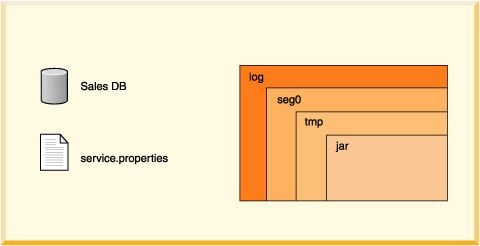A Derby database is stored in files that live in a directory of the same name as the database. Database directories typically live in system directories.
A database directory contains the following, as shown in the following figure.
- log directory
Contains files that make up the database transaction log, used internally for data recovery (not the same thing as the error log).
- seg0 directory
Contains one file for each user table, system table, and index (known as conglomerates).
- service.properties file
A text file with internal configuration information.
- tmp directory
(might not exist.) A temporary directory used by Derby for large sorts and deferred updates and deletes. Sorts are used by a variety of SQL statements. For databases on read-only media, you might need to set a property to change the location of this directory. See "Creating Derby Databases for Read-Only Use".
- jar directory
(might not exist.) A directory in which jar files are stored when you use database class loading.
Read-only database directories can be archived (and compressed, if desired) into jar or zip files. For more information, see Accessing a read-only database in a zip/jar file.
The following figure shows the files and directories in the Derby database directories that are used by the Derby software.
Derby imposes relatively few limitations on the number and size of databases and database objects. The following table shows some size limitations of Derby databases and database objects:
| Type of Object | Limit |
|---|---|
| tables in each database | java.lang.Long.MAX_VALUE Some operating systems impose a limit to the number of files allowed in a single directory. |
| indexes in each table | 32,767 or storage |
| columns in each table | 1,012 |
| number of columns on an index key | 16 |
| rows in each table | No limit. |
| size of table | No limit. Some operating systems impose a limit on the size of a single file. |
| size of row | No limit. Rows can span pages. Rows cannot span tables so some operating systems impose a limit on the size of a single file, which results in limiting the size of a table and size of a row in that table. |
For a complete list of restrictions on Derby databases and database objects, see the Derby Reference Manual.
